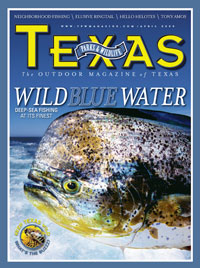
Wild Thing: Pocket Gopher
These tiny rodents can move more than a ton of soil in a year.By Sheryl Smith-Rogers
As a graduate student, Gerrad Jones surveyed mammals on the Padre Island National Seashore, live trapping everything from mice to skunks and bats. Catching a pocket gopher (Geomys personatus), however, wasn’t so easy.
“During my two years on Padre, I only caught one or two,” he says of the burrowing rodents that rarely surface. “I tried a hundred times, but every time, they’d just fill my trap with sand.”
That’s what pocket gophers do best — bulldoze dirt and dig more tunnels. In fact, one gopher can move more than a ton of soil in a year, quite a feat for an animal weighing less than a pound. Research has even shown that gophers — serving as mini rototillers to loosen soils — enhance an ecosystem. Gardeners plagued with gopher hills, however, would likely disagree.
Texas pocket gophers — named for their fur-lined cheek pouches that open from the outside — prefer the deep, sandy soils found in South Texas.
They live alone — except to breed and nurse young — in tunnel systems excavated with their long-clawed forepaws and powerful incisors. Within their dark habitats, gophers — which can’t see or hear well — navigate using their sensitive whiskers and tail. Meticulous housekeepers, they designate chambers for nesting, food storage and tossing fecal pellets.
Above ground, these avid diggers produce several fan-shaped mounds per day. Openings are always plugged with dirt to keep out coyotes, snakes and other predators. Tunneling turns up tasty roots and bulbs, which are stuffed in cheek pouches and later emptied in a storage chamber, or eaten on the spot. Perhaps to get the most from digested food, gophers occasionally eat their own pellets, a behavior common to select rodents.
“They’ll also grab nearby plants when surfacing,” Jones tells. “Late one evening, I was watching a gopher clean out its den. I picked an Indian blanket and stuck it about an inch in front of its face. After a second or two, the gopher reached out and cut the stem into two with one bite. Then — in the blink of an eye! — was gone. And so was the flower.”

